Of all Marbella’s many assets, one probably stands out above all others: the weather. This enclave of the Costa del Sol originally attracted the world’s jet set because of its year-round good temperatures.
During the off-season months it’s got its own little microclimate of warm weather. When it’s at its hottest – during July and August – there’s often a light breeze from the Mediterranean to take the edge off… perfect.
So, month by month what should you do – and wear – on a trip to Marbella?
January

Temperatures: The deepest darkest winter and perma-grey is what northern Europeans are used to during January. But bright blue skies and moderate temperatures of 17°C highs are the norm down in Marbella. January is the coldest of the months and has an average of 5 days of rainfall, but it definitely beats dark winter days up in northern Europe.
What to pack: It’s still winter, so either side of midday there’s a chill. If you’re visiting in January you might be wanting to take in some of the incredible historic sights southern Spain has to offer. Make sure you pack comfortable shoes as a whole day strolling round a fort complex like the Alcazaba in Malaga or the Albaycin area of Granada is punishing on the soles of your feet. Layers are key and a coat is necessary for January visits.
Great for… Golfers and culture vultures.
February

Temperatures: Average temperate highs of 18°C and lows of 8°C February can feel cold, certainly during the evening and early morning. When the sun rises, the sheer amount of light and largely blue skies is a tonic in itself.
What to pack: Much the same as January. Worth packing waterproof shoes as when it rains it really does rain. Rarely, though, does it rain for days and days in a row. But you might be unlucky enough to experience some rain during a stay in February.
Great for… Active travellers. Wind surfing, kite surfing, cyclists, hikers, cavers and even canyoning for those brave enough.
March

Temperatures: March in Marbella starts to touch on 20°C and high teens are reliable. Spring is in the air with flowers blooming.
What to pack: The big blue sky is there and lunch al fresco is possible. But you’re still in trousers and a coat.
Great for… Winter sun and those who want to get active. The coast is quieter but doesn’t have an out-of-season vibe at all. If you want to hike the many mountainous routes, November to March is a great time to challenge yourself.
April
Temperatures: There are days in April where it feels almost warm enough to sunbathe. Temperatures can reach 21°C and drop to an average of 11°C. Often April showers do put in an appearance.
What to pack: Still pack layers and a mac is ideal for the chillier nights or the occasional rain shower. You’ll find yourself pealing off the layers while sitting in the sun during lunch.
Great for… Culture. April sees Easter celebrations all around Spain; these huge processions are particularly famous in southern Spain. It’s one of the ‘Andalucian’ experiences.
May

Temperatures: The temperatures certainly reach sunbathing heat, but the sea is still a little chilly – although that doesn’t stop many going for a swim. The mountains haven’t been scorched by the summer sun yet, so they’re lush and green. May is very much like October with temperatures hovering around 24°C.
What to pack: Time to wear summer dresses and shorts, but take a cover-up for the evenings.
Great for… Culture vultures, early summer birders and botanists. May in Marbella is a riot of colour and a wonderful month to explore Malaga province as a whole. The beaches are quiet and the sights are still not at capacity. May marks the start of the summer season for the beach clubs as their opening parties are held during this month.
June
Temperatures: Summer is here: June can see temperatures reach above 30°C and hit an average of 28°C.
What to pack: Your best beach attire, swimwear and cooler than cool evening dress. It’s summer clothes from now on until October.
Great for… Young families and empty-nesters. It’s hot but not too hot, so you’ll still have enough energy to do fun things, too. Pools and the sea can be enjoyed but earlier in the month they’ll be chilly. San Juan is celebrated at the end of June with the longest day of the year. Coastal towns such as Marbella have parties on the beach and it’s the official start to the summer.
July & August

Temperatures: When July and August hits it’s easy to see why the siesta exists. The heat can be punishing and the best place for anyone is in a pool or on the beach.
Great for… Total rest and relaxation. If you’re wanting to flop and drop the height of summer is fabulous plus there’s nothing better than the feel of a Spanish town when the sun goes down in the summertime.
If FOMO gets the better of you and you want to sight-see or be active, very early mornings are an absolute must.
September

Temperatures: Average highs of 28°C mean that it’s still beach and pool weather. The schools in Marbella tend to go back between the first and second week of September, so water parks close around this time but other theme parks stay open into the autumn.
What to pack: Summer threads still. It’s hot.
Great for… Families with preschool children. After the height of summer the residual heat flows into September and beach days, late nights and general summertime vibes still reign supreme.
October

Temperatures: Much like May the temperature drops in October to around 24°C. October often sees a bit of rain – not a lot, but there is rainfall. October is a great month for active tourism. You’d definitely want a villa with a heated pool from now until June.
What to pack: Clothes-wise you’re likely to be out of the height of summer attire. Pack shorts and light trousers, as well as layers and a light jacket as the evenings can start to become chilly.
Great for… Multi-gen families, golfers, hikers and culture vultures.
November & December
Temperatures: November sees average temperatures of 20°C, and December a little lower at 17°C.
What to pack: Winter clothes and an umbrella. The sky will likely be blue but until midday it can feel cool. A light-weight jumper can be worn during the day especially if you’re lunching in the sun. The umbrella is just in case.
Great for… Golfers, sightseers and northern Europeans who are wanting to escape the perma-grey.
Wondering what to do it if might rain? We have a fabulous selection of Spanish villas with games room, or even villas with a gym, for when you want to burn off some energy without heading out.
Still can’t decide which month is perfect for you? Check out our When to Visit Andalucia post for more tips on what to do during each month. If you’d like to look for availability, our Marbella villa pages can help you.
You might also like





